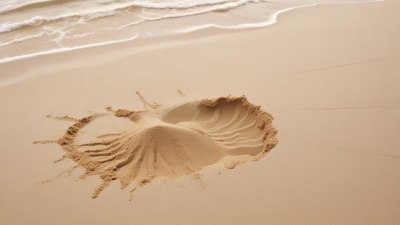How Beach Sand Clings to You Like It Has a Personal Vendetta
Discover the science and experience behind why beach sand sticks to your skin and belongings persistently.

This image was created with the assistance of Freepik
Beach days are often filled with sunshine, surf, and relaxation, but there’s one pesky phenomenon that seems to accompany every trip to the shore: sand. It clings to your skin, infiltrates your belongings, and sometimes feels as if it has a personal vendetta against you. This article delves into the reasons behind sand's relentless grip, exploring both the science and the sensations that accompany this quirky aspect of beach life.
When we think about sand, we often picture the golden grains shimmering under the sun, forming beaches that are perfect for sunbathing and relaxation. However, once we step onto the sandy shores, we quickly realize that this beautiful material has a mind of its own. No matter how hard we try to brush it off, sand seems to cling to our skin, towels, and beach gear with an almost stubborn determination.
The Composition of Sand
To understand why sand sticks to us so tenaciously, we must first consider what sand actually is. Sand is primarily composed of small fragments of rock, minerals, and shells, and the texture of these grains can vary widely. For example, beach sand can be gritty, coarse, or silky, depending on its mineral composition and the local environment. Most commonly, beach sand consists of quartz, which is made of silicon dioxide. This specific arrangement creates a structure that encourages grains to bond together and cling to surfaces, including our skin.
Additionally, the shape of sand grains plays a significant role in how they interact with our skin. Many sand grains are rounded due to erosion, which allows them to roll and shift easily. However, these rounded grains also create air pockets that trap moisture. When you apply sunscreen or body lotion, it creates a sticky surface on your skin, which gives sand the perfect opportunity to latch on tightly.
Electrostatic Attraction
A more scientific explanation for sand's clinginess involves the phenomenon of electrostatics. When you walk on sand or engage in any form of agitation, you create friction that can generate static electricity. This electrostatic charge can cause the sand particles to stick to your skin or clothing, making it even more challenging to shake off. The interplay between physical texture and static charge creates a perfect storm for sand to cling tenaciously to you.
Moreover, there’s a social aspect to this phenomenon. When you’re at the beach, it’s quite likely that others are also enjoying the sun and surf. This can lead to sand being transferred from one person to another, as grains don’t know where to stay. One person's towel may be covered in sticky sand that could easily jump onto someone else's swimsuit or beach bag. This cross-contamination can make it feel as though the sand has developed a vendetta against everyone at the beach!
The Mood-Enhancing Power of the Beach
Interestingly, the emotional connection we have with the beach can also influence how we perceive sand's clinginess. For many, the beach represents relaxation and freedom, but when we bring home grains of sand that refuse to let go, it can feel bothersome. Every grain of sand stuck to your body or in your belongings may serve as a reminder of the blissful moments spent by the sea, even as it grows frustrating. This duality is part of what makes the beach experience both enjoyable and irritating.
There's also an element of nostalgia tied to the sensation of sand against our skin. Whether it’s a family vacation or a romantic getaway, sand is mixed with memories, making its clinginess feel more like a bittersweet embrace than an annoyance.
Managing the Sand Situation
While it may be impossible to prevent sand from clinging to you entirely, there are methods you can use to mitigate its effects. First and foremost, choosing sand-resistant beach towels or mats can make a world of difference. These products are designed with special materials that prevent sand from sticking, allowing you to enjoy your beach day without worrying about bringing half the beach home with you.
Another effective method is to use baby powder or cornstarch on your skin before heading to the beach. The powder creates a protective barrier that makes it easier to brush off sand when you’re ready to leave. Just be cautious with this approach, as it can sometimes lead to more mess if the wind picks up.
The Upside of Sand
Despite its annoying clinginess, sand does have some positive aspects. For one, it’s an essential component of coastal ecosystems, providing habitat for a variety of species and playing a crucial role in protecting shorelines from erosion. Moreover, sand can be surprisingly versatile in the right hands. From sandcastle-building contests to playful games of beach volleyball, sand also fuels creativity and fun.
Furthermore, the health benefits of spending time at the beach are numerous. The beach offers a serene environment that has been shown to decrease stress, improve mood, and even enhance mental health. The sound of waves crashing, the warmth of the sun, and the smell of salty sea air work together to create an unparalleled atmosphere of relaxation. In this context, even if sand clings to you, it’s a small price to pay for the joy of beach time.
Persistent Memories
At the end of the day, the struggle to get rid of sand may become an exaggerated token of our experiences at the beach. Each time you find a grain of sand nestled in your belongings, it can evoke memories of laughter, sunlight, and quality time spent with loved ones. The stubborn sand that sticks to you serves as a reminder of the joyful moments, even long after you've left the beach behind.
So, the next time you find yourself frustrated with the relentless cling of beach sand, take a moment to appreciate the science behind it and the memories it represents. While it may feel like the sand has a personal vendetta, it is simply a part of the unique beauty and experience of a day at the beach. Embrace it, enjoy it, and remember that these little nuisances are what make our summer memories so fond. Whether it’s the laughter of children playing in the waves or the warmth of a sunset after a long day, the journey to the beach is always worth a little extra sand. Ultimately, you can choose to view the sand as a pesky intruder or a token of cherished moments spent by the sea.











